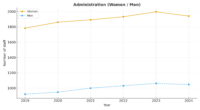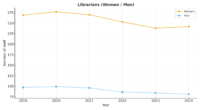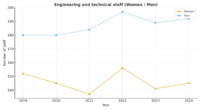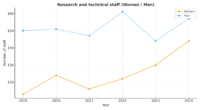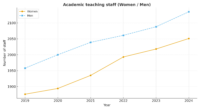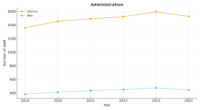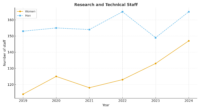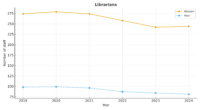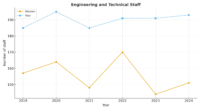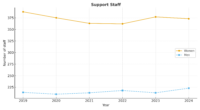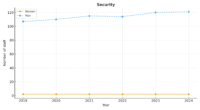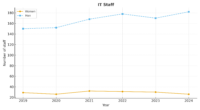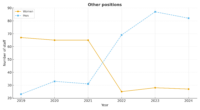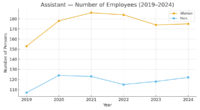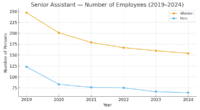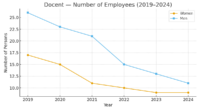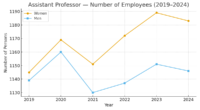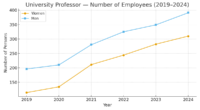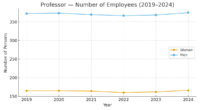Gender structure of employees at the University of Warsaw
Gender structure of employees
Between 2019 and 2024 overall employment increased, but gender changes are generally small and vary across groups. Among academic teaching staff the numbers of women and men rose by similar amounts (women +175, men +177), so the female share remained virtually unchanged — from about 48.9% in 2019 to about 49.0% in 2024.
In research-and-technical positions the number of women increased by 31 (men by 7), and the female share rose from about 43.0% to about 48.0%. By contrast, in the engineering-and-technical group the female share fell from about 46% to about 43.0%.
Libraries experienced an overall decline in employment (−43), but the male decline was proportionally larger, so the female share edged up slightly (from about 73.5% to about 74.9%) — women therefore remain a clear majority in this category. Administration grew for both women (+158) and men (+127), but the female share dipped slightly (from about 66.0% to about 65.0%).
Overall, women gained 330 positions and men 307, so the sector’s gender structure stayed stable (female share from about 55.9% to about 55.6%).
The most notable trends are the rise in female staffing within research-and-technical roles (a larger increase than for men) and the continued, slightly stronger male predominance in engineering-and-technical positions; libraries are the only major category to shrink in headcount while still having a high share of women.
Gender structure of non-academic employees
Between 2019 and 2024, employment in non-scientific positions increased from 3,710 to 3,995. This increase was systematic but moderate, indicating stable organizational development. At the same time, the gender structure of employment remains clearly unbalanced – women consistently constitute over 60% of the total workforce (62.7% in 2024).
The largest concentrations of women are found in the administrative, library, and support (service) sectors. For example, in 2024, 1,527 women and 445 men worked in administration, meaning that women constitute over 77% of this occupational group.
In contrast, men dominate technical and physical occupations – particularly in IT, security, and transportation. In these sectors, women constitute only a small percentage of the workforce.
Although the overall number of employees in each occupational group changes slightly, the gender structure remains virtually unchanged. It would be advisable to take steps to increase the representation of women in technical sectors and men in administrative or library professions.
Gender structure of academic employees
Between 2019 and 2024, the total number of academic staff increased from 3,804 to 4,105 (+7.9%), with a nearly equal rise among women (+156) and men (+145). Women now represent 48.7% of all employees, showing a gradual move toward gender parity.
The largest group remains assistant professors (adiunktki/adiunkci) – about 2,300 people annually, with an almost perfect gender balance. A slight growth was observed among assistants, while the number of senior assistants declined by over 40%. The docent category, once significant, has become marginal, dropping from 43 to 20 persons.
The most dynamic increase occurred among university professors, whose numbers more than doubled (from 310 to 701), reflecting the expansion of this career stage, especially among women. In contrast, the full professor group remained stable (around 530 persons), though men still make up about 70%.
Overall, the data indicate a process of moderate feminisation of the academic workforce. Women are gradually advancing to higher academic ranks, yet substantial gender disparities persist at the top of the academic hierarchy. The employment structure remains stable, with a slow but steady move toward gender equality.

